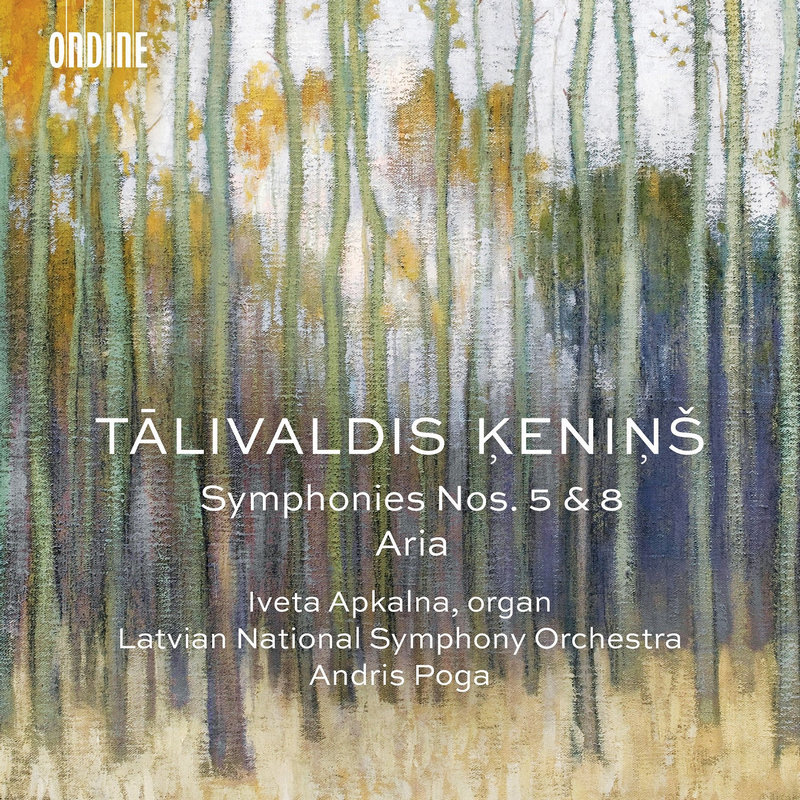
A long-standing interest of mine is exploring symphonies by composers i’ve never heard of. Apropos: Tālivaldis Ķeniņš, who until relatively recently i didn’t know was one of Latvia’s foremost 20th century composers. However, Ķeniņš was arguably as much Canadian as Latvian; after Russia re-occupied Latvia during World War II, Ķeniņš (aged in his early 30s) decided to emigrate, remaining in Canada until his death in 2008. For the last couple of years, the Ondine label has been working their way through his eight symphonies in a series of recordings featuring the Latvian National Symphony Orchestra conducted by Andris Poga, the most recent of which, featuring the fifth and eighth symphonies, was released recently.
These two symphonies date from the later period of his career, composed in 1976 and 1986 respectively. Though both are relatively short (at least, by late Romantic standards), it’s striking the degree to which Ķeniņš crams them with energy and narrative interest, never really allowing the music a chance to draw breath, always pushing it along. On the strength of these two examples, at least, Ķeniņš was a symphonist concerned more with concise (even compressed) focal point rather than expansive world-building.
With a duration of 20 minutes, Symphony No. 5 consists of a single movement subdivided into four sections that correspond to the conventional four-movement symphonic structure. That short running time means that Ķeniņš hits the ground not merely running but practically at a sprint, the opening Molto animato underpinned by a driving rhythmic motif, something that characterises both of these symphonies overall. Less a first movement than a fiery introductory salvo, it’s followed by a lengthier episode that, while it instantly halves the tempo, ultimately ramps up the energy even further. Barely glimpsed hitherto, lines start to make more headway here, navigating their way outward amidst ongoing rhythmic obstacles, finding real weight in the hands of the strings, introducing the symphony’s first demonstratively lyrical idea. All the same, it’s driven along with emphatic percussive thuds, a process suggesting some internal conflict due to the way the violins sound increasingly fraught. The line breaks apart and everything returns to the hectic pace and behavioural busyness from earlier.
Only in the third section (Largo espressivo) does Ķeniņš allow the music to draw breath, but here too the urge to ruminate is challenged and ultimately undone by its metric impulse, first appearing as an unobtrusive chugging behind a searching oboe melody, but slowly infiltrating the line of melodic thought such that, at its high point (though before becoming climactic), it fragments, leading to a thoughtful aftermath until the chugging returns to usher in what amounts to the finale. Despite the possibility of earlier divisions, it’s hard to hear this as anything other than united playfulness, moving at breakneck speed (practically metronomic at its core) while continually changing shape, its scurrying material being hurled between instrumental sections like a wild game of catch. Nonetheless, it’s the changeability that figures most here, Ķeniņš indulging in an ongoing behavioural push-pull that keeps yanking the tempo back for periods of brief meditation, allowing the winds some moments of beautiful counterpoint. It’s a superbly unpredictable way to bring the symphony to a close, opting not to tap into all the boundless energy but instead petering out in a surprisingly introspective fashion.

Composed 10 years later, Ķeniņš subtitled his 24-minute Symphony No. 8 “Sinfonia concertata” in reference to the dualistic nature of the work, pitting an organ against the orchestra. That being said, though, the first movement practically pits everyone against everyone else, the instruments all seeming to vie for attention during the opening couple of minutes. Whereupon the real antagonist steps up, blasts from the organ getting the orchestra riled up and triggering a highly rhythmic response. Though Ķeniņš clearly enjoys the argumentative nature of the music, he’s interested in more than that, as the movement swiftly ends up (in echoes of the Fifth Symphony) with more instrumental chugging alongside soft organ clusters in what amounts to an equilibrium, which in turn leads to an altogether more sympathetic dialogue, ending to a curious but beautiful only-just-plausible resolution, low sustained chords below a gentle xylophone.
Though titled ‘Chorale’, the middle movement is highly unconventional, a fact established at its outset in a wonderfully weird assemblage of low drones, high clusters, remote wind filigree, discreet organ chords and a genuinely bizarre unstable muted trombone idea that sounds like a cross between a lament and drunken rambling. The makings of a chorale do make their way to the surface, bringing about a climax, but it’s really not what this movement is about, progressing first to a soaring violin line over minimalistic organ arpeggios, and an ambiguous sequence where the music becomes polarised into slow-moving strata coated with small amounts of percussive glitter. The subsequent return of the chorale idea is elaborated by a pair of muted trumpets, adding to its tone of solemnity, the organ taking it further into realms of darkness. It really is a fantastically effective soundworld that Ķeniņš creates here, where nothing feels certain or can be taken for granted. All of which means that the closing ‘Toccata’ tends to feel a bit generic or overfamiliar coming in its wake. It’s a return to the fast velocity and driving rhythms heard before, organ and orchestra fully united by this stage, chasing each other around, continually trying to outdo and / or outwit each other. Though demonstrating the same carefree character as the finale of Symphony No. 5, Ķeniņš actively undermines this around a minute before the end, in a huge deep brass parp that cancels out pretty much everything, making the conclusion a rather gorgeous mix of low organ judder and soft lines floating like wisps on the air.
The album is completed with Ķeniņš’ 1984 Aria for strings, a short meditative work that’s especially interesting for its emotional neutrality, projecting neither an obviously positive or negative tone of voice. With a language that sometimes brings to mind Shostakovich – both in its tangentially triadic harmonies and its tendency to punctuate the continuity with reductions to individual lines – it again features the presence of a chugging idea, which once again infiltrates into and modulates the otherwise highly lyrical writing. But as the title suggests, it’s a piece that above all suggests effortless, endless song, so effortless in fact that the ending is hard to believe, a final pizzicato note that seems at odds with the music’s motivation sing on forever.
There’s a lot to get excited about in this music, and these superb performances by the Latvian National Symphony Orchestra make a strong case for Tālivaldis Ķeniņš becoming a much more familiar name in the history of the symphony.
Released by Ondine, Symphonies Nos. 5 & 8 is available on CD and download.

An interest that you’ll be well aware I share from previous discussions! Here’s another for you (another that I’m amazed I’ve never mentioned during the course of said discussions), all to chillingly relevant to the current state of geopolitics…
Thanks Chris! Never heard of that piece or that composer, so…
[…] [In] Symphony No. 8 “Sinfonia concertata” …, the first movement practically pits everyone against everyone else, the instruments all seeming to vie for attention during the opening couple of minutes. Whereupon the real antagonist steps up, blasts from the organ getting the orchestra riled up and triggering a highly rhythmic response. Though titled ‘Chorale’, the middle movement is highly unconventional, a fact established at its outset in a wonderfully weird assemblage of low drones, high clusters, remote wind filigree, discreet organ chords and a genuinely bizarre unstable muted trombone idea that sounds like a cross between a lament and drunken rambling. […] There’s a lot to get excited about in this music, and these superb performances … make a strong case for Tālivaldis Ķeniņš becoming a much more familiar name in the history of the symphony.” [reviewed in May] […]